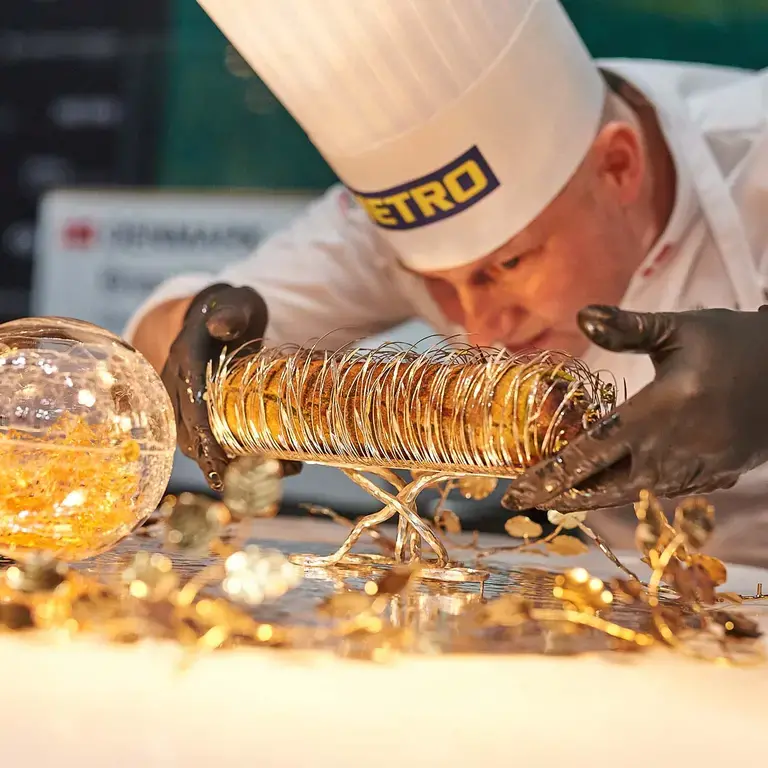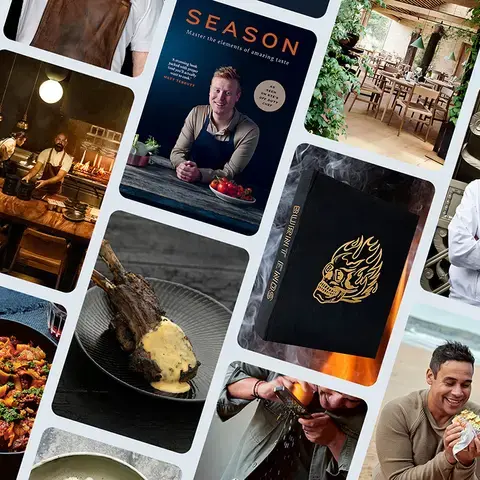Bocuse d'Or Europe 2022: Day two
The second day the Bocuse d’Or Europe competition came to a close late afternoon in Budapest. After a first day full of emotion, the teams from Finland, Spain, Hungary, the Netherlands, the United Kingdom, Latvia, Norway, Turkey and Sweden were up next to present their culinary creations to the jury.
Discover how each team performed below:
Finland
The Finnish team presented a neat, spring-like and surprising 'trompe l’oeil' vegetarian dish, which was both complex and technical. Behind its traditional and minimalist appearance, the dish featured potatoes in association with green asparagus with a touch of caramelised cheese and smoked sauce. The Finnish platter was a true tribute to beauty, presenting the main ingredient of venison with great finesse and balance.
Spain
Next, Spain offered a vegetarian dish called 'The millefeuille duo of the new world': the potato being the symbol of the birth of a new world. It was a warm and creamy dish, which presented a springtime millefeuille, with a well-balanced flavour. The taste of the potato has been exalted with aromatic herbs and seasonal mushrooms. The very complex and rich line-up highlighted the quality of the Spanish team. The meat dish was characterised by a great balance of flavours between herbs, black trumpet mushrooms, venison and foie gras. Respecting the Spanish tradition of tapas, certain elements of the dish could be eaten with one’s hands.
Hungary
The Hungarian team's vegetarian dish was complex and unique, with a careful composition. The flavour of the potato was enhanced by a touch of caviar and cucumber, which gave freshness to the dish. In all it was a plate that, according to the jury, had a lot of taste and balance.
Netherlands
The Netherlands team presented a vegetarian dish highlighting two essential products from the country: potatoes and flowers. The main ingredient was prepared with six different techniques. The taste of the potato was honoured, in association with the aioli and the tarragon, which gave it a touch of freshness. The Dutch platter surprised the jury for its colourful and inviting sunny side.
United Kingdom
The United Kingdom presented a vegetarian dish inspired by ingredients symbolising the start of spring. It was a clean dish, with a balanced composition and varied textures, a simplicity that the jury also appreciated on the set. It showcased perfectly cooked meat, peppery sauce and a balance of late winter flavours. The gourmet meat dish was simple and authentic, rare qualities in the kitchen.
Latvia
Next up, Latvia prepared a vegetarian dish called 'Spring Awakening': a lightly smoked potato fritter with a spring onion salad and morels as a condiment. The platter surprised the jury for its balance of sweet and savoury flavours, with the presence of beets and fruit, in perfect harmony with the flavour of the meat.
Norway
Spring, technique and simplicity: the three key words to describe the Norwegian team's vegetarian dish. It was a fine and technical dish, where the potato was presented in the shape of an egg. The jury was very impressed with the Norwegian platter, which presented the perfect balance of Nordic flavours and ingredients.
Turkey
Turkey's vegetarian dish resembled the three types of Hungarian potatoes with great originality. It was a floral springtime dish, enriched with Turkish spices for a Mediterranean touch. The meat platter, enriched with sumac, fruits and roots, represented the Anatolian heritage with a lot of technique and passion.
Sweden
Finally, Sweden created a fun and bright vegetarian dish, presented in an original way. The potato was the protagonist, on a crisp and flowery base. The taste of the dish was enhanced by a champagne and herb sauce. The meat dish also impressed the jury with its balanced and fresh side, given by the peas served as an accompaniment. A dish with a refined composition and a slightly umami flavour.
Day one round-up
After hours of prep and cooking in the morning, the teams began the all-important plating and presentation for the jury. The jury members were introduced to the audience at the location and the excitement escalated.
Here's how each team performed:
Poland
Team Poland were the first to plate their creations, starting with their vegetarian dish - pureed potato in a honeycomb structure - a play on crunchy and soft textures with a horseradish sauce on the side. “The crunchiness is definitely there and I really like the horseradish and potatoes together. This dish is all about the textures”. The plate lands somewhere between a starter and a sweet. The first platter of the day was impressive form Poland, their first appearance in the Bocuse d’Or, with plenty of earthy flavours to enhance the venison.
Estonia
Estonia presented their three-potato dish, full of colour and evocative of a spring garden in three pieces. It was comfort food with a playful splash of cucumber and dill, presented in a fresh and interesting way. Estonia’s meat platter was a very solid presentation unafraid to flirt with sweet elements to play off the strong game flavour of the venison, with the aroma of morels and a good firmness to the foie-gras.
Denmark
Denmark is always high-achieving in this competition and their presentation exhibited the usual precision and attention to detail. A light presentation with plenty of colour with fine elements and employing a lot of techniques. Denmark’s meat platter, as expected, was spectacular in presentation with many spring elements. A high bar for other contestants to reach for.
France
The reigning champions are this year led by the first female chef to represent the country, 24-year-old Naïs Pirollet, who is also the only female chef at Bocuse d’Or Europe. The team presented their light and seasonal vegetarian plate with green asparagus. The plate, called ‘Influence’, presented potato cooked in different textures - crispy, soft and melting - and imbued with local flavours, a combination of French cuisine and Hungarian ingredients. It was a very elegant plate with a feminine touch, and the lightness of the main element made a great dish with finely tuned technique. After the presentation of the plate, chef Pirollet put the finishing touches to the meat platter, which looked stunning – less elaborate than some of the others, but confident, with panache. The platter was a representation of French tradition and creativity. There was a purity of ingredients, with mango and onion to add liveliness, but the game was very much to the fore and cooked to perfection.
Slovakia
Slovakia’s vegetarian dish leaned into spring with its colours and flavours. The dish looked more like a presentation of a seasoned Bocuse d’Or contestant, considering it’s Slovakia’s first time competing. A match of earthy and sweet with pickles and mushrooms gave the impression of a spring garden, a theme echoed in Slovakia’s meat platter, which was presented with plenty of floral elements. A simple and direct approach that emphasises cottage cheese with an Italian ravioli, plenty of sweetness and good balance.










